 | | | Switch to: Europe, USA, New Zealand, Antarctica Credit: NOAA/Ovation  Planetary K-index Planetary K-index
Now: Kp= 1.67 quiet
24-hr max: Kp= 3.00 quiet
explanation | more data
Interplanetary Mag. Field
Btotal: 7.37 nT
Bz: -3.71 nT south
more data: ACE, DSCOVR
Updated: Today at 1152 UT  Coronal Holes: 13 Nov 24 Coronal Holes: 13 Nov 24 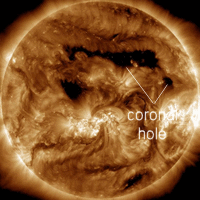
Solar wind flowing from this coronal hole could graze Earth's magnetic field on Nov. 14-15. Credit: SDO/AIA  Polar Stratospheric Clouds
Colorful Type II polar stratospheric clouds (PSC) form when the temperature in the stratosphere drops to a staggeringly low -85C. NASA's MERRA-2 climate model predicts when the air up there is cold enough: 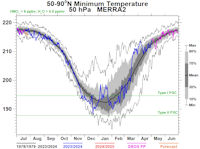
On Nov. 11, 2024, the Arctic stratosphere is cooling but still too warm for Type II polar stratospheric clouds. | more data. Noctilucent Clouds
The northern season for NLCs is underway--but not for long. The first clouds were detected inside the Arctic Circle on May 25, 2024, by the NOAA 21 satellite. After peaking in July, the clouds are now in rapid decline. This is typical for the month of August, which usually brings the end of NLC season in the northern hemisphere.
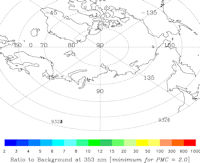
Updated: Aug. 28, 2024
An instrument onboard NOAA 21 (OMPS LP) is able to detect NLCs (also known as "polar mesospheric clouds" or PMCs). In the daily map, above, each dot is a detected cloud. As the season progresses, these dots will multiply in number and shift in hue from blue to red as the brightness of the clouds intensifies.
 SPACE WEATHER
NOAA Forecasts | | Updated at: 2024 Nov 13 2200 UTC FLARE | 0-24 hr | 24-48 hr | CLASS M | 60 % | 60 % | CLASS X | 20 % | 20 % |  Geomagnetic Storms: Geomagnetic Storms:
Probabilities for significant disturbances in Earth's magnetic field are given for three activity levels: active, minor storm, severe storm Updated at: 2024 Nov 13 2200 UTC Mid-latitudes | 0-24 hr | 24-48 hr | ACTIVE | 35 % | 30 % | MINOR | 15 % | 15 % | SEVERE | 01 % | 01 % | High latitudes | 0-24 hr | 24-48 hr | ACTIVE | 10 % | 15 % | MINOR | 25 % | 30 % | SEVERE | 50 % | 40 % | | | |  | | | | | | | | | | | This is an AI Free Zone! Text created by Large Language Models is spreading rapidly across the Internet. It's well-written, artificial, frequently inaccurate. If you find a mistake on Spaceweather.com, rest assured it was made by a real human being. | | | QUIET WITH A CHANCE OF FLARES: Solar activity has been low for the past 24 hours. The calm might not last. Sunspot AR3889 has an unstable delta-class magnetic field that poses a threat for significant explosions. NOAA forecasters estimate a 25% chance of X-flares on Nov. 13th. Solar flare alerts: SMS Text TRIMETHYL ALUMINUM CLOUDS OVER NORWAY: They're completely harmless, says NASA. Twisting clouds of trimethyl aluminum (TMA) appeared over Norway on Nov. 10th during a minor geomagnetic storm. Ivar Sandland photographed them from Narvik, a small town inside the Arctic Circle: 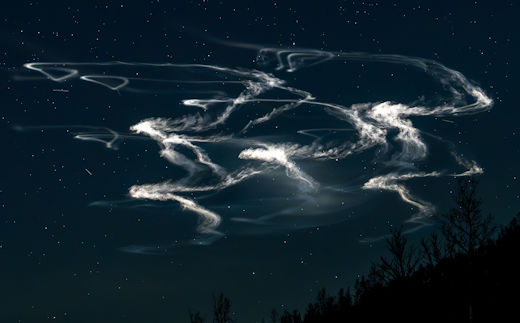
Moments earlier, Sandland watched a rocket climb through colorful auroras. "It was a rocket launch from Andoya Space center in northern Norway," he explains. "Moments later, the clouds appeared." The NASA rocket carried 16 canisters of trimethyl aluminum, which were released into the upper atmosphere. Glowing clouds were visible from the ground, allowing researchers to study waves and vortices in air ~100 km above Earth's surface, a region which also contains the turbopause. This is fundamental research that may help improve computer models of our planet's atmosphere. Realtime Aurora Photo Gallery
Free: Spaceweather.com Newsletter JABBA THE HUTT SPACE MUG: Want a cup of coffee with one of the Galaxy's most powerful gansters? The Jabba the Hutt Space Mug is for you! On Nov. 10, 2024, it flew to the stratosphere onboard a cosmic ray research balloon: 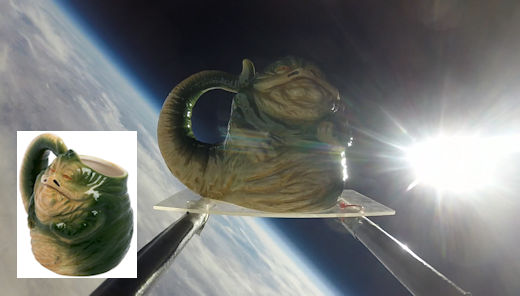
You can have it for $99.95. This extra large ceramic mug holds 26 oz. of piping hot coffee. It's also a great soup bowl. At the apex of the flight, the cup floated 107,773 feet above the Sierra Nevada mountains while sensors inside the balloon's payload gathered radiation data for a student science project. The cup comes with a greeting card showing Jabba in flight, and certifying that the cup traveled to the edge of space and back again. Get yours now! Far Out Gifts: Earth to Sky Store
All sales support hands-on STEM education RUSH HOUR SATELLITE TRAFFIC: There are now more than 10,000 active satellites in Earth orbit. Dan Bush of Albany, Missouri, photographed dozens of them during "satellite rush hour" on Nov. 12th: 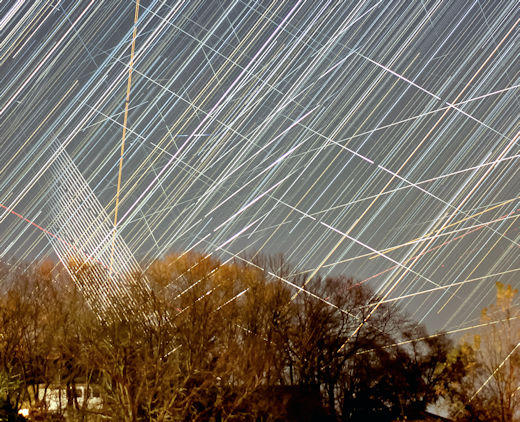
"I've posted several videos on YouTube recently showing the crowded skies full of satellites as filmed by the Missouri Skies automated meteor cameras," says Bush. "This is a star trail image shot with a DSLR showing the busy traffic along my predawn eastern horizon." In this long exposure, the stars are trailing from lower left to upper right. Almost everything else is a satellite. "A group of recently launched Starlink satellites can be seen forming the multiple (20+) parallel lines at center," notes Bush. No wonder the International Astronomical Union has set up a center for the protection of dark skies from satellites. It's a real problem--and it's going to get worse. Realtime Space Weather Photo Gallery
Free: Spaceweather.com Newsletter
Realtime Comet Photo Gallery
Free: Spaceweather.com Newsletter
Realtime Aurora Photo Gallery
Free: Spaceweather.com Newsletter Every night, a network of NASA all-sky cameras scans the skies above the United States for meteoritic fireballs. Automated software maintained by NASA's Meteoroid Environment Office calculates their orbits, velocity, penetration depth in Earth's atmosphere and many other characteristics. Daily results are presented here on Spaceweather.com. On Nov 13, 2024, the network reported 29 fireballs.
(25 sporadics, 2 northern Taurid, 1 Leonid, 1 November iota Draconid) 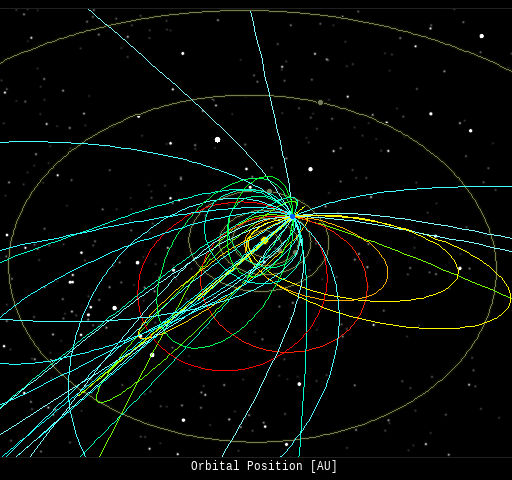 In this diagram of the inner solar system, all of the fireball orbits intersect at a single point--Earth. The orbits are color-coded by velocity, from slow (red) to fast (blue). [Larger image] [movies] Potentially Hazardous Asteroids ( PHAs) are space rocks larger than approximately 100m that can come closer to Earth than 0.05 AU. None of the known PHAs is on a collision course with our planet, although astronomers are finding new ones all the time. On November 13, 2024 there were 2349 potentially hazardous asteroids.
 | Recent & Upcoming Earth-asteroid encounters: | Asteroid | Date(UT) | Miss Distance | Velocity (km/s) | Diameter (m) | | 2024 VR2 | 2024-Nov-08 | 9.6 LD | 8 | 30 | | 2024 VY | 2024-Nov-08 | 2.2 LD | 18.6 | 20 | | 2024 VS | 2024-Nov-08 | 3.4 LD | 11.8 | 11 | | 2024 UK13 | 2024-Nov-08 | 10.4 LD | 10 | 17 | | 2024 UK9 | 2024-Nov-08 | 4.3 LD | 4.4 | 13 | | 2024 VJ2 | 2024-Nov-08 | 4.5 LD | 12.6 | 16 | | 2024 VJ3 | 2024-Nov-08 | 2.6 LD | 9.2 | 15 | | 2024 UU9 | 2024-Nov-09 | 14.5 LD | 8.8 | 17 | | 2024 VE | 2024-Nov-09 | 5.5 LD | 10.4 | 23 | | 2024 UU4 | 2024-Nov-09 | 19.4 LD | 5.7 | 15 | | 2024 VB3 | 2024-Nov-09 | 9.3 LD | 7.2 | 24 | | 2024 VL2 | 2024-Nov-09 | 8.1 LD | 6.8 | 27 | | 2024 UZ | 2024-Nov-10 | 16.4 LD | 4.9 | 19 | | 2024 VY3 | 2024-Nov-10 | 2 LD | 11 | 10 | | 2024 UC3 | 2024-Nov-10 | 11 LD | 6.6 | 28 | | 2024 UK8 | 2024-Nov-11 | 19.7 LD | 18.7 | 21 | | 2024 VC3 | 2024-Nov-11 | 15.9 LD | 12.9 | 46 | | 2024 VA4 | 2024-Nov-11 | 2.8 LD | 10 | 32 | | 2019 WB7 | 2024-Nov-11 | 17.3 LD | 5.7 | 43 | | 2024 UE4 | 2024-Nov-11 | 3.4 LD | 12.5 | 29 | | 2024 VH1 | 2024-Nov-12 | 1.3 LD | 10 | 17 | | 2020 UL3 | 2024-Nov-12 | 4.1 LD | 10.5 | 80 | | 2020 AB2 | 2024-Nov-13 | 18.9 LD | 7.2 | 14 | | 2024 VO2 | 2024-Nov-13 | 11.4 LD | 6.8 | 14 | | 2024 VX3 | 2024-Nov-13 | 0.4 LD | 7 | 8 | | 2024 VV1 | 2024-Nov-14 | 19 LD | 6 | 15 | | 2024 UA10 | 2024-Nov-14 | 19.1 LD | 15.5 | 31 | | 2019 VU5 | 2024-Nov-14 | 12 LD | 23.3 | 46 | | 2019 VL5 | 2024-Nov-14 | 9.6 LD | 8.5 | 24 | | 2024 UE13 | 2024-Nov-15 | 19.7 LD | 7.9 | 27 | | 2024 VK3 | 2024-Nov-16 | 1.1 LD | 11.1 | 11 | | 2024 VS3 | 2024-Nov-16 | 4.3 LD | 13.1 | 21 | | 2024 VC4 | 2024-Nov-16 | 6.5 LD | 19.3 | 29 | | 2024 VZ2 | 2024-Nov-17 | 3.3 LD | 10.2 | 22 | | 2024 UC5 | 2024-Nov-17 | 10.8 LD | 4.2 | 19 | | 2024 VT3 | 2024-Nov-18 | 12.6 LD | 12.3 | 40 | | 2023 WK3 | 2024-Nov-18 | 16.1 LD | 14.5 | 272 | | 2024 UZ10 | 2024-Nov-18 | 11.6 LD | 13.2 | 47 | | 2024 VU2 | 2024-Nov-19 | 15.1 LD | 8.7 | 41 | | 2012 KO11 | 2024-Nov-20 | 6.2 LD | 9.4 | 43 | | 2024 UW9 | 2024-Nov-20 | 13.5 LD | 14.8 | 45 | | 2020 VX4 | 2024-Nov-20 | 10.5 LD | 10.5 | 11 | | 2010 WC | 2024-Nov-21 | 1.9 LD | 9.1 | 31 | | 2024 VY2 | 2024-Nov-24 | 16.4 LD | 13.3 | 54 | | 2009 WB105 | 2024-Nov-25 | 15.1 LD | 18.9 | 71 | | 2006 WB | 2024-Nov-26 | 2.3 LD | 4.2 | 98 | | 2018 DC4 | 2024-Nov-29 | 18.8 LD | 4.5 | 12 | | 2019 JN2 | 2024-Nov-30 | 9.4 LD | 7.7 | 25 | | 2021 XZ | 2024-Dec-02 | 13.2 LD | 7.4 | 8 | | 447755 | 2024-Dec-03 | 14.4 LD | 12.2 | 402 | | 2020 XR | 2024-Dec-04 | 5.8 LD | 12.3 | 388 | | 2021 WA5 | 2024-Dec-05 | 9.8 LD | 5.9 | 12 | | 2024 UU3 | 2024-Dec-08 | 16.9 LD | 4.8 | 38 | | 2018 XU3 | 2024-Dec-11 | 16.8 LD | 10.8 | 28 | | 2007 XB23 | 2024-Dec-11 | 1.2 LD | 4.8 | 14 | | 2022 YO1 | 2024-Dec-17 | 2 LD | 14.3 | 4 | | 2020 XY4 | 2024-Dec-19 | 12.8 LD | 8.8 | 14 | | 2017 YD2 | 2024-Dec-27 | 18 LD | 9.9 | 6 | | 2024 AV2 | 2024-Dec-31 | 6.7 LD | 7.8 | 17 | | 2021 AO4 | 2025-Jan-04 | 6.9 LD | 15.1 | 11 | | 2020 BC6 | 2025-Jan-05 | 9.6 LD | 22.2 | 248 | | 2024 BM1 | 2025-Jan-08 | 11.5 LD | 9.1 | 22 | | 2024 PT5 | 2025-Jan-09 | 4.7 LD | 1 | 12 | | 2023 OS3 | 2025-Jan-09 | 19.9 LD | 3.1 | 10 | | 2012 UK171 | 2025-Jan-11 | 10.7 LD | 6.4 | 46 | Notes: LD means "Lunar Distance." 1 LD = 384,401 km, the distance between Earth and the Moon. 1 LD also equals 0.00256 AU. | | Cosmic Rays in the Atmosphere | SPACE WEATHER BALLOON DATA: Almost once a week, Spaceweather.com and the students of Earth to Sky Calculus fly space weather balloons to the stratosphere over California. These balloons are equipped with sensors that detect secondary cosmic rays, a form of radiation from space that can penetrate all the way down to Earth's surface. Our monitoring program has been underway without interruption for 7 years, resulting in a unique dataset of in situ atmospheric measurements. Latest results (July 2022): Atmospheric radiation is decreasing in 2022. Our latest measurements in July 2022 registered a 6-year low: 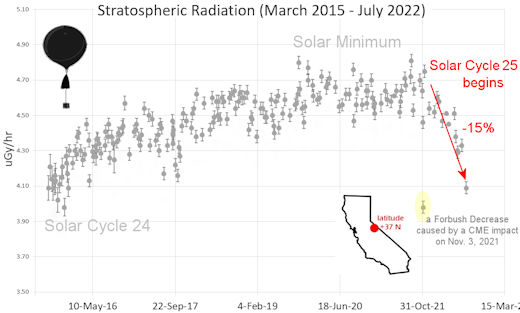
What's going on? Ironically, the radiation drop is caused by increasing solar activity. Solar Cycle 25 has roared to life faster than forecasters expected. The sun's strengthening and increasingly tangled magnetic field repels cosmic rays from deep space. In addition, solar coronal mass ejections (CMEs) sweep aside cosmic rays, causing sharp reductions called "Forbush Decreases." The two effects blend together to bring daily radiation levels down. .Who cares? Cosmic rays are a surprisingly "down to Earth" form of space weather. They can alter the chemistry of the atmosphere, trigger lightning, and penetrate commercial airplanes. According to a study from the Harvard T.H. Chan school of public health, crews of aircraft have higher rates of cancer than the general population. The researchers listed cosmic rays, irregular sleep habits, and chemical contaminants as leading risk factors. A number of controversial studies (#1, #2, #3, #4) go even further, linking cosmic rays with cardiac arrhythmias and sudden cardiac death. Technical notes: The radiation sensors onboard our helium balloons detect X-rays and gamma-rays in the energy range 10 keV to 20 MeV. These energies span the range of medical X-ray machines and airport security scanners. Data points in the graph labeled "Stratospheric Radiation" correspond to the peak of the Regener-Pfotzer maximum, which lies about 67,000 feet above central California. When cosmic rays crash into Earth's atmosphere, they produce a spray of secondary particles that is most intense at the entrance to the stratosphere. Physicists Eric Regener and Georg Pfotzer discovered the maximum using balloons in the 1930s and it is what we are measuring today. | | The official U.S. government space weather bureau | | | The first place to look for information about sundogs, pillars, rainbows and related phenomena. | | | Researchers call it a "Hubble for the sun." SDO is the most advanced solar observatory ever. | | | 3D views of the sun from NASA's Solar and Terrestrial Relations Observatory | | | Realtime and archival images of the Sun from SOHO. | | | information about sunspots based on the latest NOAA/USAF Active Region Summary | | | current counts of failed and deployed Starlink satellites from Jonathan's Space Page. See also, all satellite statistics. | | | Authoritative predictions of space junk and satellite re-entries | | | from the NOAA Space Environment Center | | | fun to read, but should be taken with a grain of salt! Forecasts looking ahead more than a few days are often wrong. | | | from the NOAA Space Environment Center | | | the underlying science of space weather |  | Got a chipped or cracked windshield that prevents you from seeing space weather events while driving? Get windshield replacement from SR Windows & Glass with free mobile auto glass service anywhere in the Phoenix area. |  | BestCSGOGambling is the best site for everything related to CSGO gambling on the web | | | These links help Spaceweather.com stay online. Thank you to our supporters! | | | | | | | | |  | |  |   | ©2021 Spaceweather.com. All rights reserved. This site is penned daily by Dr. Tony Phillips. | |

